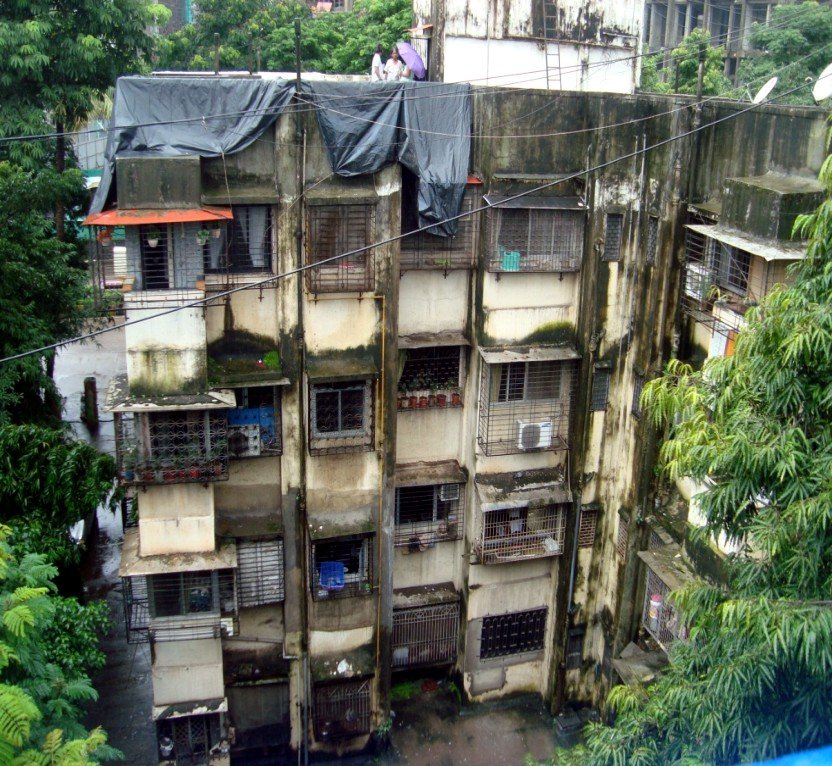Since redevelopment started in 1991 about two decades ago, and builders could augment the FSI (Floor Space Index) of the land by purchasing TDR (Transfer of Development Rights), cooperative housing societies started neglecting their structures. Seduced by builders who promise larger houses and new buildings, building societies have been keen to steamroll opposition to their redevelopment proposals by individual members by deliberately allowing their building to deteriorate, so that structural auditors can declare them as “dilapidated”. Earlier, it was a nightmare for a society to be told that its building was structurally unsound, and managing committee members and general body members alike were anxious to avoid it by regular re-plastering, painting and repairing. But in the last two decades, a report from structural engineers saying that the building is “dilapidated” or is in need of “major rapairs” has been the dream of every managing committee, because it legitimizes their quest for redevelopment.
Redevelopment is a gravy-train by which everybody gets to make money, and especially civic authorities who give various building permissions, cooperative department officials, and the managing committees of societies. Many residential buildings aged around 30 and above would have been in a relatively better state, were it not for this lust for redevelopment. Despite a fair number of stalled redevelopment projects, and the opposition by cautious members in every society, the greed-is-good ethos of the majority of members in almost every society ensures that this gravy train is gaining momentum.
Brief overview of Mumbai’s redevelopment over the last two decades: http://tinyurl.com/History-
Over 10 percent of Mumbai’s 30,000-odd society buildings are currently suffering from varying degrees of redevelopment-driven neglect by their managing committees, which collect money for their Repair Fund and Sinking Fund every month, but never spend for repairs and maintenance, Hoping to reap windfall gains from redevelopment, the managing committees favour a dilapidated appearance, which sends a come-hither signal to builders.
Sadly, every such society will not enter into the process of redevelopment swiftly; the overwhelming majority of old buildings will have to wait for many years before their redevelopment happens. Hence, residents are condemned by their greedy and negligent managing committees to live for long in buildings with fast-deteriorating RCC columns, beams and slabs.
In every society, one or two people are fighting a losing battle against this commercially-driven madness. They are seeking better maintenance of their societies. Most often, their voices are raised only at meetings, and this makes them pariahs. Far from recognizing that their words are in the common interest, a majority of their neighbours consider them mad, and shun them. Their managing committees are quick to paint them as anti-social villains opposed to the prosperity that will be brought about by redevelopment.
One such person is Rohit D’Souza (9819199863, rohitpdsouza@gmail.com), a young sportsman of Mulund. Due to the constant leakage and seepage from the rooftop tank, and the consequent rusting and deterioration of the building structure, Rohit and his neighbours fear for their lives, and have written many letters to their building secretary and to to MCGM’s Ward Officer for T-Ward. But their letters may as well have been written by residents of thousands of other residents of Mumbai, who are in the same boat: http://tinyurl.com/Please-
Numerous societies are in exactly the same boat. Improper structural maintenance by societies due to greed, cost cutting, ignorance, unavailability of skilled labourers, disputes between members etc. is endangering the lives of thousands of families living in Mumbai. The steel in the RCC columns, beams and slabs has rusted and become exposed in many buildings, and Rohit’s building is only a sample of what thousands of buildings are currently looking like. Like Rohit, lakhs of people in Mumbai region are saying, “We are not opposed to redevelopment per se, but we are definitely opposed to the deliberate neglect of our buildings, which is a growing threat to our lives.”
But are the government and municipal authorities listening? And more importantly, are the managing committee members listening?
Or will they, like the Municipal Corporations of Mumbai, Mumbra, Thane etc. wake up only after the building crashes down?
Issued in Public Interest by
Krish
9821588114
PS: After reading this, if residents of societies wish to gently start reminding their societies to maintain the building, they may use this word file as a format: http://tinyurl.com/sample-



DATE : 27.01.15
DEAR SIR/MADAM,
OURS IS A REGISTERED HOUSING SOCIETY AT THANE.
OUR BUILDING IS 20 YRS OLD AND STRUCTURAL AUDIT IS ALREADY CONDUCTED.
IN ADDITION TO MAJOR STRUCTURAL REPAIRS, WE HAVE DECIDED TO RE-PLASTER WHOLE BUILDING.
IN OUR BUILDING THERE ARE ABOUT 15 SHOPS. PER FLOOR THERE ARE 3 FLATS AND AREA OF ALL THREE DIFFERS.
WHETHER STRUCTURAL REPAIRS ARE TO BE SHARED EQUALLY OR ACCORDING TO THE SIZE OF EACH FLAT.
ALSO WHETHER RE-PLASTERING EXPENSES TO BE SHARED EQUALLY OR ACCORDING TO THE SIZE OF THE FLAT.
WHAT EXPENSES WE CAN ASK FOR, FROM SHOP OWNERS.
I THANK YOU IF YOU PLEASE, KINDLY, EXPRESS YOUR OPINION AT YOUR EARLIEST.
YOURS FAITHFULLY,
R S KAMATH